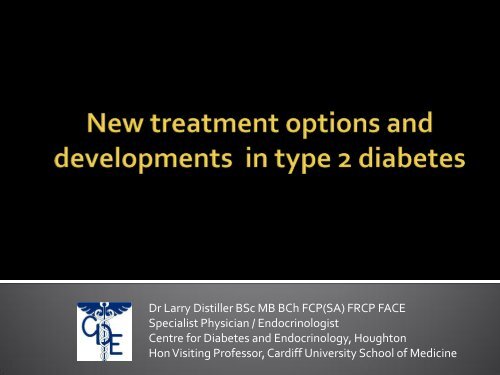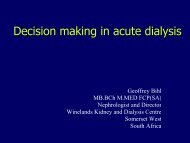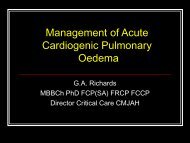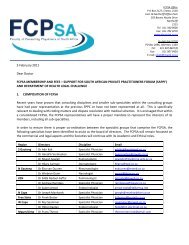Dr Larry Distiller BSc MB BCh FCP(SA) FRCP FACE Specialist ...
Dr Larry Distiller BSc MB BCh FCP(SA) FRCP FACE Specialist ...
Dr Larry Distiller BSc MB BCh FCP(SA) FRCP FACE Specialist ...
You also want an ePaper? Increase the reach of your titles
YUMPU automatically turns print PDFs into web optimized ePapers that Google loves.
<strong>Dr</strong> <strong>Larry</strong> <strong>Distiller</strong> <strong>BSc</strong> <strong>MB</strong> <strong>BCh</strong> <strong>FCP</strong>(<strong>SA</strong>) <strong>FRCP</strong> <strong>FACE</strong><br />
<strong>Specialist</strong> Physician / Endocrinologist<br />
Centre for Diabetes and Endocrinology, Houghton<br />
Hon Visiting Professor, Cardiff University School of Medicine
Obesity Sedentary lifestyle Aging Genetics Glucotoxicity FFA levels<br />
Insulin resistance<br />
Beta-cell function<br />
Blood glucose<br />
Adequate<br />
Insulin response<br />
Inadequate<br />
Euglycaemia<br />
Type 2 diabetes<br />
Adapted from Matthaei et al. Endocrine Reviews 2000;21:585-618.<br />
Adapted from Edelman. Adv Intern Med 1998;43:449-500.
And many more in<br />
development<br />
Bianchi C et al. Diabetes Voice 2011;56:28-31
• What are the incretins and gliptins?<br />
• Why should we use them?<br />
• When should they be used?<br />
• Should we be using them?
• What are the incretins and gliptins?
Potent enhancers of glucose induced insulin<br />
secretion<br />
• Glucose-dependant insulinotropic<br />
polypeptide, (GIP), formerly called gastric<br />
inhibitory polypeptide<br />
• Glucagon-Like Polypeptide 1 (GLP-1)
L-cell<br />
(ileum)<br />
ProGIP<br />
Proglucagon<br />
GLP-1 [7–37]<br />
GIP [1–42]<br />
GLP-1 [7–36 NH 2 ]<br />
K-cell<br />
(jejunum)
GLP-1: Secreted upon the<br />
ingestion of food<br />
Promotes satiety and<br />
reduces appetite<br />
Alpha cells:<br />
Postprandial<br />
glucagon secretion<br />
Beta cells:<br />
Enhances glucose-dependent<br />
insulin secretion<br />
Liver:<br />
Glucagon reduces<br />
hepatic glucose output<br />
Stomach:<br />
Helps regulate gastric<br />
emptying<br />
Data from Flint A, et al. J Clin Invest. 1998;101:515-520; Data from Larsson H, et al. Acta Physiol Scand. 1997;160:413-422<br />
Data from Nauck MA, et al. Diabetologia. 1996;39:1546-1553; Data from <strong>Dr</strong>ucker DJ. Diabetes. 1998;47:159-169
• Slower gastric emptying<br />
- Direct effect on gastric emptying<br />
• Feeling of satiety<br />
- Blocks satiety centre centrally<br />
• Reduction in post-prandial glucose levels<br />
- Direct effect on insulin secretion (incretin effect)<br />
- Suppression of glucagon
Plasma Glucose (mg/dL)<br />
C-peptide (nmol/L)<br />
Oral Glucose<br />
Intravenous (IV) Glucose<br />
200<br />
2.0<br />
1.5<br />
*<br />
*<br />
*<br />
*<br />
Incretin Effect<br />
* *<br />
*<br />
100<br />
1.0<br />
0.5<br />
0<br />
0.0<br />
0<br />
60 120 180<br />
Time (min)<br />
0<br />
60 120 180<br />
Time (min)<br />
N = 6; Mean (SE); *P0.05<br />
Data from Nauck MA, et al. J Clin Endocrinol Metab. 1986;63:492-498
Nauck MA, Baller B, Meier JJ. Gastric inhibitory polypeptide and<br />
glucagon-like peptide-1 in the pathogenesis of type 2 diabetes. Diabetes.<br />
2004;53(suppl 3):S190-S196.<br />
• The incretin effect is severely reduced or even<br />
abolished in patients with Type 2 diabetes<br />
• Secretion of GIP is near-normal in most patients<br />
with Type 2 diabetes, but insulinotropic effect of<br />
GIP is largely ablated in type 2 diabetes, even<br />
when infused at supraphysiologic levels<br />
• The secretion of GLP-1 is significantly impaired<br />
Nauck MA, Baller B, Meier JJ. Diabetes.2004;53(suppl 3):S190-S196.
IR Insulin, mU/L<br />
IR Insulin, mU/L<br />
80<br />
60<br />
Control Subjects<br />
(n=8)<br />
Incretin<br />
Effect<br />
0.6<br />
0.5<br />
0.4<br />
80<br />
60<br />
Patients With Type 2 Diabetes<br />
(n=14)<br />
The incretin effect<br />
is diminished<br />
in type 2 diabetes.<br />
0.6<br />
0.5<br />
0.4<br />
40<br />
0.3<br />
40<br />
0.3<br />
0.2<br />
0.2<br />
20<br />
0.1<br />
20<br />
0.1<br />
0<br />
0<br />
0<br />
0<br />
0<br />
Time, min<br />
Oral glucose load<br />
60 120<br />
180<br />
0<br />
60 120<br />
Time, min<br />
180<br />
Intravenous (IV) glucose infusion<br />
Adapted from Nauck M et al. Diabetologia. 1986;29:46–52. Copyright © 1986 Springer-Verlag.
GLP-1 (but not GIP) increases both early- and late-stage insulin secretion<br />
Data are mean±SEM. GIP, gastric inhibitory peptide; type 2 diabetes patients (n=8)<br />
Vilsbøll et al. Diabetologia 2002:45:1111–9
Mean (SE); n=10; *p
The Problem<br />
Native GLP-1 and GIP are broken down by<br />
DPP-4 in 1-2 minutes<br />
The Solution ?<br />
- GLP-1 analogues<br />
- DPP-4 inhibitors
• Exenatide (Byetta®, Eli Lilly)<br />
• Liraglutide (Victoza®, NovoNordisk)<br />
Others in the pipeline
• Synthetic version of the salivary<br />
protein found in the Gila monster<br />
• More than 50 % amino acid<br />
sequence identity with human GLP-1<br />
▪<br />
▪<br />
Binds to known human GLP-1 receptors<br />
Resistant to DPP-4 inactivation<br />
Following injection, exenatide is measurable in plasma<br />
for up to 10 hours<br />
Nielsen LL, et al. Regul Pept. 2004;117:77-88<br />
Kolterman OG, et al. Am J Health-Syst Pharm. 2005;62:173-181
• A slightly modified version of the GLP-1<br />
molecule that attaches to albumin and<br />
therefore is released slowly, adopting the<br />
pharmacokinetic profile of albumin<br />
• The plasma half-life for this compound is<br />
12 hours. It therefore provides exposure<br />
for over 24 hours following a single<br />
subcutaneous injection
• Vildagliptin (Galvus® ,Novartis)<br />
• Saxagliptin (Onglyza®, AstraZenica)<br />
• Sitagliptin (Javunia® , Merck)<br />
• Linagliptin (Tradjenta®, BI / Eli Lilly)<br />
• Alogliptin
Ingestion of<br />
food<br />
Release of<br />
active incretins<br />
GI tract GLP-1 and GIP<br />
Pancreas<br />
Beta cells<br />
Alpha cells<br />
Glucose<br />
dependent<br />
Insulin<br />
(GLP-1 & GIP)<br />
Glucose<br />
uptake by<br />
peripheral tissue<br />
Blood glucose in<br />
fasting and<br />
postprandial states<br />
DPP-4<br />
inhibitor<br />
Inactive<br />
GLP-1<br />
X<br />
DPP-4<br />
enzyme<br />
Inactive<br />
GIP<br />
Glucosedependent<br />
Glucagon<br />
(GLP-1)<br />
Hepatic<br />
glucose<br />
production<br />
GLP-1=glucagon-like peptide-1; GIP=glucose-dependent insulinotropic polypeptide.
GLP-1 Analogues<br />
• Supra-physiological levels of GLP-1<br />
DPP4-Inhibitors<br />
• Approaches physiological levels of GLP-1
*GLP-1 levels for liraglutide calculated as 1.5% free liraglutide<br />
Degn et al. Diabetes 2004;53:1187–94; Mari et al. J Clin Endocrinol Metab 2005;90:4888–94
GLP-1 Analogues<br />
• Supra-physiological levels of GLP-1<br />
• Significant and sustained weight loss<br />
• Injected therapy<br />
• Potential GIT Side-effects<br />
• Low rates of hypoglycaemia<br />
• Improved CV risk factors<br />
insulin secretion<br />
glucagon release<br />
food intake, slow gastric emptying<br />
DPP4-Inhibitors<br />
• Approaches physiological levels of GLP-1<br />
• Weight neutral<br />
• Oral therapy<br />
• Minimal GIT side-effects<br />
• Low rates of hypoglycaemia<br />
• Limited data on CV risk factors<br />
insulin secretion<br />
glucagon release
What are the incretins and gliptins?<br />
• Why should we use them?<br />
• When should they be used?<br />
• Should we be using them?
• Why should we use them?
• Exenatide (twice daily)<br />
• Liraglutide (once daily)
Change from baseline to 30 weeks<br />
HbA 1c (%)<br />
Body weight (kg)<br />
Existing oral<br />
therapy<br />
Exenatide<br />
5 µg bid<br />
Exenatide<br />
10µg bid<br />
Exenatide<br />
5 µg bid<br />
Exenatide<br />
10 µg bid<br />
Sulphonylurea 1 0.46 § 0.86 § 0.9 1.6*<br />
Metformin 2 0.40 ‡ 0.78 ‡ 1.6 § 2.8 §<br />
Metformin +<br />
0.60 0.80 1.6 † 1.6 †<br />
sulphonylurea 3<br />
*p
A1C (%)<br />
Weight (kg)<br />
104-Week Completers at Week 30<br />
104-Week Completers at Week 104<br />
0.0<br />
Mean baseline A1C: 8.2%<br />
0<br />
Mean baseline weight: 101 kg<br />
-1<br />
-0.5<br />
-2<br />
-3<br />
-1.0<br />
-4<br />
-5<br />
-1.5<br />
-6<br />
104-wk Completers; N = 195; Mean (SE); Weight is a secondary endpoint<br />
Data on file, Amylin Pharmaceuticals, Inc.
Significant *vs. comparator; # Change in HbA 1c from baseline for overall population (LEAD-4,-5) add-on to diet and exercise failure (LEAD-3);<br />
or add-on to previous OAD monotherapy (LEAD-2,-1)<br />
Marre et al. Diabetic Medicine 2009;26;268–78 (LEAD-1); Nauck et al. Diabetes Care 2009;32;84–90 (LEAD-2); Garber et al. Lancet 2009;373:473–81 (LEAD-3); Zinman et al.<br />
Diabetes Care 2009; 32:1224–30 (LEAD-4); Russell-Jones et al. Diabetologia 2009;52:2046–55 (LEAD-5)
• Weight and blood pressure did not differ between add-on<br />
and switch concept<br />
*Change calculated by ANCOVA analysis<br />
Nauck et al. Diabetes 2009;58(Suppl. 1):A122 (abstract 459-P)
• Waist circumference<br />
was reduced from baseline<br />
by 3.0 cm<br />
with liraglutide 1.8 mg<br />
• Waist circumference<br />
increased by 0.4 cm with<br />
glimepiride (p
• Both liraglutide and exenatide were combined with met and/or SU<br />
Buse et al. Lancet 2009;374:39–47 (LEAD-6)
Buse et al. Lancet 2009;374:39–47 (LEAD-6)
Mean (2SE)<br />
Buse et al. Lancet 2009;374:39–47 (LEAD-6)
Buse et al. Lancet 2009;374:39–47 (LEAD-6)
GLP-1 receptors are expressed in multiple organs including:<br />
• Pancreas<br />
• Peripheral tissue<br />
• Central nervous system<br />
• Heart<br />
• Kidney<br />
• Lung<br />
• Gastrointestinal tract<br />
• GLP-1 appears to have a range of neurotrophic<br />
neuroprotective and cardioprotective effects
GLP-1 receptors have been localized t0:<br />
▪ Cardiomyocytes<br />
▪ Endocardium<br />
▪ Microvascular endothelium<br />
▪ Coronary artery smooth muscle cells;
Heart (myocardium)<br />
• Protects against Ischaemia /<br />
reperfusion injury<br />
• Improves myocardial function<br />
Vascular System<br />
• Improves Endothelial function<br />
• Vasorelaxation<br />
GLP-1<br />
The Kidney<br />
• Increased diuresis and Na + excretion<br />
Adapted from:<br />
Chilton R et al. The American<br />
Journal of Medicine 2011;124,<br />
S35–S53
• Promote Weight loss<br />
• Lower Triglyceride and raise HDL<br />
• Lower Blood pressure (?)<br />
• Improve endothelial dysfunction<br />
• Reduce CRP and other inflammatory markers<br />
• Increase myocardial insulin sensitivity<br />
• Increase myocardial glucose uptake<br />
Koska J et al Diabetes Care 2010;33:1028-1030<br />
Courreges JP et al Diabetes Medicine 2008;25:1129-1134<br />
Nikolaidis LA st al. Circulation 2004;110:955-961<br />
Bhashyam S. Et al Circ Heart Fail 2010;3:512-521
In Addition:<br />
• Reduced monocyte adhesion to endothelial cells promoted<br />
by inhibition of the inflammatory response to macrophages<br />
• Development of atherosclerotic lesions was suppressed in<br />
mice<br />
• GLP-1 was found to enhance coronary blood flow after<br />
induced ischaemia in rats<br />
• In one study, exenatide treated animals were shown to have as much as<br />
40 % reduction in MI size when compared with controls<br />
Chilton R et al. The American Journal of Medicine 2011;124, S35–S53
• No effect of Exenatide 10 µg on QT interval<br />
• No relevant increases in the QTc interval using liraglutide<br />
once daily<br />
• No prolongation of the QT interval using exenatide once<br />
weekly<br />
Chatterjee DJ et al. J Clin Pharmacol 2009;49:1353-59<br />
Amylin Pharmaceuticals. Data on file.
• LifeLink Study<br />
39,000 patients treated with exenatide were compared with<br />
[approximately] 390,000 patients treated with all other<br />
interventional strategies<br />
Significant decrease in cardiovascular events with Exenatide<br />
(hazard ratio, 0.81; [95 % confidence interval, 0.68-0.95;<br />
P=0.01]), indicating a 16 % decrease in cardiovascular events<br />
Best JH et al. Diabetes Care 2011;34:90-95
Vilsboll T et al. BMJ 2012;344:d7771doi: Published Jan 2012
Vilsboll T et al. BMJ 2012;344:d7771doi: Published Jan 2012
Exenatide<br />
Liraglutide<br />
Administration<br />
s.c. Twice daily s.c. Once daily<br />
Mean Reduction in HbA 1c ~o.8-1.1 % ~1.1-1.5 %<br />
Mean reduction in FPG ~0.6 mmol/l ~1.7 mmol/l<br />
Mean reduction in body weight 2.87 kg 3.24 kg<br />
Persistence of nausea (after 26 weeks) 10 % 5 %<br />
Liraglutide appears the better option on all fronts, but this may change with<br />
once-weekly exenatide which seems better than daily liraglutide<br />
Adapted from: Buse et al. Lancet 2009;374:39–47 (LEAD-6)
• Vildagliptin (Galvus® ,Novartis)<br />
• Saxagliptin (Onglyza®, AstraZenica)<br />
• Sitagliptin (Javunia® , Merck)<br />
• Linagliptin (Tradjenta®, BI / Eli Lilly)<br />
• Alogliptin
‡<br />
Change in A1C, %<br />
‡<br />
Change in FPG, mg/dL<br />
‡<br />
Change in 2-hr PPG, mg/dL<br />
0.0<br />
-0.2<br />
-0.4<br />
-0.6<br />
-0.8<br />
-1.0<br />
A1C<br />
Mean Baseline: 8.0 %<br />
P
Triangle, sitagliptin (100 mg qd)<br />
Circle, vildagliptin (50 mg bid or 100 mg qd)<br />
Square, saxagliptin (5 mg qd);<br />
Diamond, alogliptin (25 mg qd)<br />
Star, linagliptin (5 mg qd)<br />
C. F. Deacon CF. Diabetes, Obesity and Metabolism 2010;13:7-18
Sitagliptin administration at a single dose of 100 mg in<br />
patients with CAD:<br />
• Preserved LV function<br />
• Enhanced LV response to stress<br />
• Improved global and regional LV performance compared<br />
with placebo<br />
Read PA. Circ Cardiovasc Imaging 2010; 3: 195–201
• No definitive evidence for this as yet.<br />
• Awaiting outcome of TECOS, <strong>SA</strong>VOR and<br />
other trials.
• Why should we use them?<br />
• When should they be used?<br />
• Should we be using them?
• When should they be used?
• While the effects on glucagon, gastric emptying<br />
and satiety may well persist, the major effect of<br />
these drugs is still on insulin secretion<br />
• Therefore, the better the residual insulin secretory<br />
capacity (the more β-cell reserve), the better the<br />
expected response
• None of these drugs are registered for first-line or<br />
monotherapy<br />
• But that is probably where they will prove to be most<br />
beneficial
Makes therapeutic sense:<br />
Basal insulin to target FPG; incretin to target PPG.<br />
• Sitagliptin has registration for use with insulin.<br />
• Exenatide has FDA approval for use with basal<br />
insulin.<br />
• Liraglutide has been shown to be effective when<br />
combined with basal insulin.
• When should they be used?<br />
• Should we be using them?
• DPP-4 is found on endothelial and epithelial cells<br />
throughout the vascular bed, and in the kidneys,<br />
intestines, exocrine pancreas, gastrointestinal tract,<br />
biliary tract, thymus, lymph nodes, uterus, placenta,<br />
prostate, myocardium, and brain, as well as the adrenal,<br />
sweat, salivary, and mammary glands.<br />
• In addition, DPP-4 is also expressed on circulating T-<br />
lymphocytes and is found in soluble form in seminal and<br />
cerebrospinal fluid and plasma.
DPP-4 inhibition has not, as yet, been associated with any<br />
human disease.<br />
• 96 DPP-4 inhibitors have shown a very positive safety and<br />
tolerability profile in clinical studies involving thousands of<br />
patients with type 2 diabetes<br />
• DPP-4 inhibitor treatment has been associated with slightly<br />
elevated risks of nasopharyngitis, bronchitis, urinary tract<br />
infection and headaches
• The debate rages!<br />
Case reports have raised concerns about an increased risk of acute<br />
pancreatitis in patients treated with GLP-1 agonists<br />
But<br />
Type 2 diabetes itself is said to be associated with a 3-fold<br />
increased risk of developing pancreatitis<br />
• So - is the incidence of pancreatitis higher with GLP-1<br />
analogues or is it just a case of “awareness”?
• A review of 10,000 patients on 19 clinical trials in patients on<br />
sitagliptin showed no increased risk of pancreatitis<br />
In all animal studies, there is no evidence that<br />
DPP4-I cause pancreatitis<br />
Engel SS et al. In J Clin Pract 2010;64:984-990<br />
C. F. Deacon CF. Diabetes, Obesity and Metabolism 2010;13:7-18
• German data base identified 11 cases of pancreatic cancer in<br />
association with exenatide<br />
• No such “signal” with DPP4-I<br />
• Exenatide promotes pancreatic ductal hyperplasia<br />
• However, the time between tumour induction, tumour growth<br />
and clinical diagnosis is > 10 years<br />
• Exenatide exposure was 2-33 months<br />
▪ ? does exenatide promote tumour progression rather than initiation
• Liraglutide induces thyroid C-cell focal hyperplasia and C-cell<br />
tumours in a dose-related manner in rats, which may lead to<br />
medullary thyroid cancer<br />
• In a 104-week exenatide carcinogenicity study in rats, an<br />
increased incidence of benign thyroid C-cell adenomas was seen<br />
(Rats develop spontaneous C-cell lesions at a high frequency, while C-cell neoplasia is extremely<br />
rare in humans)<br />
• This has not been seen in any of the clinical studies performed to<br />
date<br />
Knudsen LB. Endocrinology 2010; 151: 1473–1486<br />
Parks M. N Engl J Med 2010; 362: 774–777
Elashoff M et al<br />
Gastroenterology<br />
2011;141:150-156
• We don’t know!<br />
• There are those who remain opposed to these drugs<br />
on basis of uncertainty<br />
• There are those who believe in these drugs implicitly<br />
• And many in-between!<br />
The jury is still out
“ History has taught us that enthusiasm for new<br />
classes of drugs, heavily promoted by the<br />
pharmaceutical companies that market<br />
them, can obscure the caution that should be<br />
exercised when long-term consequences are<br />
unknown”<br />
Peter Butler. Diabetes Care 2010
• We are constantly being pressurised by industry to<br />
prescribe newer and more expensive drugs<br />
• For most of us, there are intangible rewards for<br />
doing this
Don’t trust me, I’m a doctor…<br />
“As to the honour and conscience of doctors,<br />
they have as much as any other class of men,<br />
no more and no less<br />
And what other men dare pretend to be impartial<br />
where they have a strong pecuniary interest on one side?”<br />
George Bernard Shaw, 1911
Thank you<br />
for your<br />
attention<br />
“Prediction is very difficult, especially about the future”<br />
Niels Bohr








